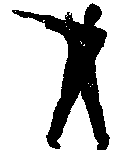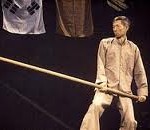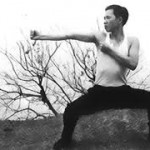The system of Wing Chun Kung Fu
Wing Chun is unique amongst the martial arts in the way in which it has been designed as a system of progressive concepts which build upon each other. There are 3 empty hand forms (or sets) a wooden dummy form, two weapons forms and the unique sticking hands practice.
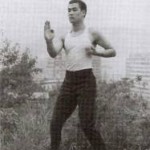 Siu Lim Tao – the little idea form
Siu Lim Tao – the little idea form
This is where the whole journey of wing chun starts. A very simple set of arm movements that form the basis of the whole wing chun system. Easy to learn and immensely profound.
The Hidden Power of Siu Nim Tau
![]()
My master Yip Man ![]() first started teaching Ving Tsun in Hong Kong at the Restaurant Worker’s Union Association. At the time I was the secretary of the association, so Master Yip and I had many opportunities to be together. Before I became interested in Ving Tsun, I often overheard Master Yip explaining his Ving Tsun theories in his classes. Gradually he sparked my interest in the art. It so happened that I had great interest in physics and mechanics; I enjoyed his theories on body structure and power development methods very much. Through my careful analysis, I was convinced that Master Yip’s art was flawless and very advanced. Finally, I decided to follow Master Yip and became his student.
first started teaching Ving Tsun in Hong Kong at the Restaurant Worker’s Union Association. At the time I was the secretary of the association, so Master Yip and I had many opportunities to be together. Before I became interested in Ving Tsun, I often overheard Master Yip explaining his Ving Tsun theories in his classes. Gradually he sparked my interest in the art. It so happened that I had great interest in physics and mechanics; I enjoyed his theories on body structure and power development methods very much. Through my careful analysis, I was convinced that Master Yip’s art was flawless and very advanced. Finally, I decided to follow Master Yip and became his student.
Like every beginner in class, I started my journey with Siu Nim Tau ![]() , even though I had already familiarized myself with the form as an observer. It took me little effort to completely learn the basic movements. I then began to wonder about the essence of the form, besides the hand movements. I went to Master Yip and inquired about the meaning of Siu Nim Tau, especially the non-combative tone in the name. Master Yip replied: “This is about Lop Nim
, even though I had already familiarized myself with the form as an observer. It took me little effort to completely learn the basic movements. I then began to wonder about the essence of the form, besides the hand movements. I went to Master Yip and inquired about the meaning of Siu Nim Tau, especially the non-combative tone in the name. Master Yip replied: “This is about Lop Nim![]() — to establish an idea in the mind”. I am sure most of my peers have also heard about this term. Master Yip also added that it required prolonged practice of this form to truly master the essence of lop nim.
— to establish an idea in the mind”. I am sure most of my peers have also heard about this term. Master Yip also added that it required prolonged practice of this form to truly master the essence of lop nim.
This hidden meaning of lop nim really caught my interest. I spent much time analyzing its nature, but could still not grasp the concept. Therefore I decided to drop all my thoughts and simply practiced Siu Nim Tau whenever I could, day and night. After a long time, I began to see the connection between lop nim and the form. I suddenly felt great joy in my Ving Tsun training, which fueled my interest in the art further. I became obsessed with the art. Gradually I discovered some powerful but hidden forces within each Siu Nim Tau movement. All the movements are indeed able to deliver indestructible power, yet they look very soft and graceful. At that moment, the concept of lop nim became extremely enlightening and inspiring to me. I finally understood the reason behind it.
I summarize this hidden power as a kind of nim lik ![]() (the force of an idea; or mind/intent force, where nim
(the force of an idea; or mind/intent force, where nim ![]() is the same idea/intent as in nim tau
is the same idea/intent as in nim tau ![]() ). In essence, Siu Nim Tau has two major points: nim lik and “structure”.
). In essence, Siu Nim Tau has two major points: nim lik and “structure”.
1. Nim Lik (force of idea/intent): it stabilizes all Ving Tsun movements to form a springy and dynamic combination of body structures. It makes Ving Tsun body structure able to sustain great pressure and produce rebound energy. Although there are common terms such as nim lik, qigong, noigong or supernatural abilities that are being perceived as some kind of unusual power, here I would only illustrate the concept behind nim lik (force of idea/intent).Nim lik is the power of a highly focused mind. It helps one bring forth chi flow into every part of the body. Everyone should have this kind of power. However, without training, it is very difficult to focus thoughts. Siu Nim Tau is a great tool to invoke mind focus power. If properly practiced, one can deliver this kind of power at will in every instance. The mind can stay focused even when the structure is adjusting or moving at high speed. So to achieve nim lik is the goal of Siu Nim Tau.
Let’s look at a simple example: if a healthy person falls down from a 6 – 7 feet tall platform unprepared, although he/she lands with both feet, he/she is still likely to injury him/herself. However, if the person is mentally prepared for the fall, his/her feet will automatically recoil and absorb the impact. Also, he/she can only have this reflex if his/her feet are relax. This is an unique attribute of human muscle in its relax state. The springy force on the feet that help the person land safely is a direct result of relax muscles and nim lik.
note: according to contemporary scientific findings; when human muscles are in relax state and are moving at steady speed, they can sustain greater pressure than when they are tensed up (using force). It is so amazing that our Ving Tsun ancestor Ng Mui ![]() was able to make use of this scientific method to design our Siu Nim Tau hundreds of years ago
was able to make use of this scientific method to design our Siu Nim Tau hundreds of years ago
2. Structure: Yee Gee Kim Yang Ma ![]() allows one to project all energy forward towards the target. Tei Gong
allows one to project all energy forward towards the target. Tei Gong ![]() (pulling up of the muscle around the anus area) helps unite body and stance. It also helps relax the leg muscles while being in the stance; thus the whole body reaches a highly alert and ready state. These are the necessary conditions to produce nim lik and must be maintained firmly. The core techniques of Siu Nim Tau — Tan
(pulling up of the muscle around the anus area) helps unite body and stance. It also helps relax the leg muscles while being in the stance; thus the whole body reaches a highly alert and ready state. These are the necessary conditions to produce nim lik and must be maintained firmly. The core techniques of Siu Nim Tau — Tan ![]() / Bong
/ Bong ![]() / Fook
/ Fook ![]() — are indeed subtle uses of body mechanics. These three techniques take the shape of arcs or bows. As we extend the arc shape further, Tan / Bong / Fook become hemispheres. As we all know, an arc or spherical-shaped object can sustain strong impact. It can also transfer or deflect energy dynamically when spinning. A wheel can accelerate faster than objects of other shapes (e.g. square, triangle). Each movement in Siu Nim Tau, inspired by this efficient arc-like structure, and when combined with nim lik, becomes extremely powerful defensive and offensive techniques. In addition, practitioners must not employ brute muscle strength. Siu Nim Tau training should never be tiring. To be proficient in this foundation, all movements should be done with the mind rather than strength.
— are indeed subtle uses of body mechanics. These three techniques take the shape of arcs or bows. As we extend the arc shape further, Tan / Bong / Fook become hemispheres. As we all know, an arc or spherical-shaped object can sustain strong impact. It can also transfer or deflect energy dynamically when spinning. A wheel can accelerate faster than objects of other shapes (e.g. square, triangle). Each movement in Siu Nim Tau, inspired by this efficient arc-like structure, and when combined with nim lik, becomes extremely powerful defensive and offensive techniques. In addition, practitioners must not employ brute muscle strength. Siu Nim Tau training should never be tiring. To be proficient in this foundation, all movements should be done with the mind rather than strength.
Many Ving Tsun practitioners like to impose their techniques into frozen and static postures. Many believe that Bong Sau should be done at certain height or angle, or criticize others for not complying to their artificial standards. Some may call this style traditionalist; that style reformist; and on and on. In fact, movements in Siu Nim Tau are not named as if they were static postures. For example, when rolling up Tan Sau into Bong Sau, it is the course of this rolling movement that makes up the Bong Sau technique; the function of Bong Sau exists in its circular motion. Similarly, all other techniques in Siu Nim Tau employ circular movements in various directions.
It is a popular belief that Bong Sau is a passive technique: practitioners only use Bong Sau to deflect incoming forces. This would apply to the scenario where a statically posted Bong Sau is being used to block attacks. However, this explanation lacks an understanding of Bong Sau. In my experience, Bong Sau can deliver enormous offensive power. Indeed, it is a very aggressive and penetrating technique due to its circular nature.
Finally, I suggest that all fellow Ving Tsun practitioners look carefully into each technique of Siu Nim Tau. Discover the subtle circular movements in each of them. Practice with mind focus and steady speed. Use the mind to command each technique rather than using muscle tension. I am sure you will gradually find great joy and satisfaction in your Siu Nim Tau training!
Tsui Sheung Tin
![]()
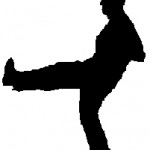 Chum Kiu form – seeking the bridge
Chum Kiu form – seeking the bridge
Building upon the energy and shapes created in the Siu lim Tao form the Chum Kiu form now introduces movement into the system creating more force as well as creating more directions of force to be utilised. It also introduces some basic kicks and leg sweeps.
Here’s an article on Chum Kiu form by my Sigung, Chu Shong Tin:
Literally, Chum Kiu when translated is the method of how to deal with the opponent’s wrists once in contact. In other words, Chum Kiu is the form applicable to fighting. If the theory of Chum Kiu is analysed carefully, it is found that it has reached the acme of perfection.
Chum Kiu is to utilize the body weight of a person as the source of energy and combining the moves of Siu Nim Tau to create a skill that can apply force in different directions. As a result, the opponent will find it difficult to tackle these kind of moves because his centre of gravity has been affected and will be easily toppled over. Hence, your chance to win in fighting is increased.
The theory of Chum Kiu can be grouped as follows: 1. The application of “two-way” force; 2. Using the centre of the body as the source of energy; 3. Using the mind to control the movement of the body; 4. Using the simultaneous attack and defence movements.
1. THE APPLICATION OF “TWO-WAY FORCE”
The majority of the moves in Chum Kiu is to apply the force moving in two different directions to contact with the wrists of the opponent. Although it is called the “two-way force”, yet, if analysed in more detail, it is found that it consists of skill of applying the force pointing from more than two directions.
The turning stance of Chum Kiu is a two-dimensional turning, i.e. turning on a surface. When the turning stance is combined with use of Tau Sau, Bong Sau and Fook Sau of Siu Nim Tau at the same time, every move of Chum Kiu will comprise the effect of having a force pointing from two different directions. Thus, the opponent will find it difficult in dealing with these kind of moves.
I was invited to organise a seminar in Holland in 1994 in which I demonstrated the “two-way force” of Chum Kiu. During the demonstration, I wrestled with a young and huge Negro who could easily lift up 250 kg. At that time, I weighed only 60 kg. As the body weights vary so greatly, my winning with the use of Chum Kiu obtained the shouts of triumph from everybody present on that occasion.
The reason why the “two-way force” is difficult to be deal with is very simple. Assume that one can easily raise up an object of 50 kg, but if a person pushes you with a force of 20 kg from the side while you are lifting an object of 30 kg then you will find it very difficult to resist the pushing and will even lose your balance and fall over.
2. Using the centre of the body as the source of energy
In practising Chum Kiu, one must use the centre of the body as the source of energy. The purpose is to maintain the body weight as an unity and then every move will contain the weight of the whole body. When the opponent is in contact with any part of your body, he will then have to suffer an attack from your whole body weight.
3. Using the mind to control the movement of the body
The purpose of using the mind to control the movement of the body is to generate the whole body weight without using any unnecessary muscular force. Thus, every move you are using will contain the weight of the whole body.
4. Using the simultaneous attack and defence movements
Practising Chum Kiu has entered into the stage of body contact with the opponent. This means that Chum Kiu is the form which will comprise of the combating skill. Hence, every simple move of Chum Kiu contains a common structure which is fit for attack or defence. Apart from having the speciality of Wing Chun (i.e. not to waste energy), every move will contain the scientific structure for combat, allowing the fighting skill to show up when facing the opponent.
It is of my opinion the fighting skill of Chum Kiu is difficult to describe in writing. The best way is to understand it is through demonstration and practice. If I have to put down all the Chum Kiu skills in writing, the article will be so profound that the person who reads it will find it hard to understand and will be confused.
Copyright ©2001 Wing Chun Kuen by Chu Shong Tin, ALL RIGHTS RESERVED.
The Bil Gee form it was said “never left the doorstep”. Meaning that it was not openly taught to all students. These days it is quite well known. Bil Gee again builds upon the power and structure of the previou two froms and then adds to them. the multi-directional forces generated by the chum kiu form are now given another axis of application. the turning movement is also added to so as to form a vortex or whirlpool effect that can both absorb and issue force as required. Kicks and leg sweeps
Here’s Sigung Chu Shong Tin’s brief article on Bil Gee:
Bill Gee is the form which concentrates an enormous destructive power in attacking. It is to use the natural skill to release the potential power of a person to the highest level and is also the combination of the mind and the theory of force.
It is wrong to say that learning the form of Bil Gee will then possess the enormous power of Bil Gee as well as having the very high skill in concentrating the force. Without the basic skill of Siu Nim Tau and Chum Kiu, the Bil Gee’s power cannot be effected. Sometimes, one may even hurt oneself when applying Bil Gee in fighting if one does not possess the basic skill of Siu Nim Tau and Chum Kiu.
To analyse the original idea of Bil Gee from the moves of the form:
1. When practising Bil Gee, one must move in speedy motion. When one is familiar with the moves of Bil Gee, he should practise it speedily because everybody knows that the destructive power is greater when moving faster.
2. Using rotation as a source of releasing energy. Whether it is as hard as steel or as soft as water, once rotated, the steel or water can generate enormous power. It is obvious that one will be unwilling to approach a rotating steel. Also, when the air is rotated, it creates a powerful hurricane. The whirlpool formed by the rotation of water is just as bad.
Hence, when practising Bill Gee, one must infuse his mind into the moves. In the way, he can feel the speedy effect and the original idea of Bil Gee so as to obtain the greatest satisfaction.
The profound Skill of Bil Gee can only expressed through demonstration, as such complexities can never be expressed in black and white. Hopefully, I wish that the participants of this course can grab hold of this profound skill so as to increase their understanding of Wing Chun. Consequently, they can practise Wing Chun with great interest.
Copyright ©2001 Wing Chun Kuen by Chu Shong Tin, ALL RIGHTS RESERVED.
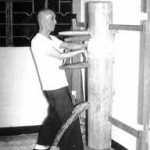 Mook Yong Jan – the Wooden dummy form
Mook Yong Jan – the Wooden dummy form
The Wooden Dummy is recognised as the highest skill in Wing Chun. Hence, the majority of Wing Chun learners consider that learning the moves of the Wooden Dummy will automatically become a good Wing Chun fighter. Some even feel very happy with themselves and boast about their own achievements to the junior learners.
The moves of the Wooden Dummy are all good for fighting. However, those moves are actually formed by the basic moves of Siu Nim Tau, Chum Kiu and Bill Gee. They are not uniquely owned by the Wooden Dummy only.
In fact, the practice of the Wooden Dummy is taken as an auxiliary measure for the training of the Wing Chun forms. If your purpose is to practise the skill of the three forms then you should treat the Wooden Dummy as a piece of equipment and try your best to practise the moves and the skill of the three forms on it. You should also try to feel if your goal has been achieved, e.g. trying to concentrate the force of the whole body to a particular point and induce the opponent’s force for your own use (N.B. to induce the opponent’s force for your own use is one of the basic structure of Bill Gee, which is the combined effect of rotation of the body and the formation of the whirlpool effect). On the other hand, if you treat the Wooden Dummy as your opponent, you should try to concentrate your own force, as well as the skill of inducing the opponent’s force, to attack the Wooden Dummy so as to attain the state that your hands can reach any part of the opponent as your mind wishes to do.
As I said before, if I describe every move of the Wooden Dummy in writing, one will find it difficult to follow and it may even lead him away from the principal goal in practising the Wooden Dummy. For this reason, I have made up my mind to show you the skill of the forms as well as the Wooden Dummy myself so that you can feel the mysterious and profound skill of the Wing Chun Kung Fu.
This form requires you to utilise all the energies and concepts from the previous three forms and apply the to the wooden dummy as you move around it. The dummy is responsive to the touch (not rigid, and not for conditioning the arms) and requires that you focus your forces accurately at its centre on each touch.
Sigung Chu Shong Tin
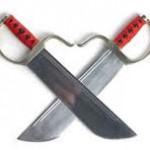 Bart Jam Do – the butterfly sword form
Bart Jam Do – the butterfly sword form
Again building upon the three empty hand forms this form requires that you generatew force to the end of the swords. Teaches more advanced stepping, advancing and retreating movements , as well as how to use the two swords simultaneously to attack and defend in line with the wing chun theory.
under construction ….more to come soon….thanks for your patience
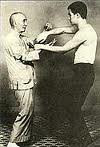 Chi Sau – Wing Chun Sticking Hands
Chi Sau – Wing Chun Sticking Hands
Chi Sau, or ‘Sticking Hands’, is a Wing Chun training exercise designed to develop close range combat skills. In close range combat, your ability to see an incoming strike or punch and react by reflex is greatly diminished, which is where the skills developed through Chi Sau apply.
The aim of Chi Sau is to learn through touch any shift in an opponent’s body position which indicates an eminent attack. Training the arms to have ‘a mind of their own’ allows a Wing Chun practitioner to instinctively break an opponent’s structure and remove their ability to apply force.
A thorough understanding of the Siu Nim Tao form is essential before a student can undertake training in Chi Sau as movements between the two forms are closely related.
Correct training in Chi Sau offers many benefits including:
- Improved hand speed;
- Shorter reaction time;
- Heightened sensitivity, allowing one to find a hole in an opponent’s defence instantly;
- More power;
- Better balance;
- The ability to control an opponent at all times; and
- The ability to apply the strongest structure against the weakest structure of the opponent.
- In practicing Chi Sau, the Wing Chun exponent learns to intercept an opponent’s arms, trap his hands and strike through simultaneously. The exercise is performed with constant forward force and the arms ‘soft’ and relaxed enough to ‘stick’ to those of the opponent.
- The arms are moved in a continuous, circular motion involving movements known as Tan Sau, Dai Sau, Fook Sau and Bong Sau. Using the concept of a circle, the Wing Chun exponent’s arms are constantly repositioned or ‘rolled’ while searching for or creating an opening in the opponent’s defence so that the Wing Chun exponent may strike through.
Chi Sau Drills
- These exercises build on the structural aspects of the Siu Nim Tao form, further developing relaxation and looseness in the joints. Students progress through Single Chi Sau, where the basics are taught using one arm, to Double Chi Sau, where both arms are used simultaneously, to refining and building the skills of both in Lap Sau.
- Once competency is attained in the static Chi Sau arm movements, stepping and pivoting is introduced, training the practitioner to utilise body mass, deflect an opponent’s force and adjust positioning. Once he is able to move freely and maintain all other Chi Sau movements, other skills including trapping, engaging and disengaging with an opponent and arm movements from the three Wing Chun empty hand forms and Mook Yan Jong (Wooden Dummy form) may be introduced.
- Blindfold fighting is a true test of Chi Sau skills, testing the ability of the practitioner’s arms to operate independently of sight and to control and manipulate a partner by touch and reflex. It takes many years of training under a qualified master before these movements become natural reactions.
Wing Chun Kung Fu contains a vast amount of theory which students need to grasp an understanding of in order to make the system work. The theory is not difficult some is quite profound. It is in the theory and understanding that Wing Chun becomes a lifestyle and a life long learning for many thousands of people all over the world.
A Brief Introduction to the Philosophy of Wing Chun
After one is familiar with all the movements in the Wing Chun Forms, he should study and understand more in depth the theory and contents of the Forms in order to establish the concept in training so that he could reach the revelation – “Lup Lim” (Means: determines to use the thinking process to achieve the basic principles of Wing Chun) – as told by the late Grandmaster Ip Man. Practicing in this way, one can be able to gain an ideal result and obtain enrichment.
Now I will give a brief description of the philosophy of Wing Chun. Wing Chun kung fu always emphasizes on not to use any muscular force but to conjugate with the mind and work it out as the source of power. This reinforces the importance of “Lup Lim” during training. I hope that the followers of Wing Chun can assimilate the logic of modern scientific theories in analysing its movements so one can learn more about the Wing Chun system and make it easier to understand why Wing Chun is so profound in its learning.
During the Ching Dynasty of China, Wing Chun was created from the life martial art experience of the Abbess Ng Mui during her latter years. Now a few hundred years later, if one use the modern scientific knowledge to analysis Wing Chun, no matter which movements, [Siu Nim Tau], [Chum Kiu] or [Bill Gee], are backed up by the logic of physics, dynamics and the theory of body structure. That is why I believe Wing Chun is an invented martial art that transcends time.
Generally, when the beginners study the movements of the Wing Chun forms, most of them will find it very difficult to comprehend. Therefore, they will concentrate on the practical application of the techniques and neglect the importance of the logic of the theories of force and structure. The more comprehendible one will after analysing Wing Chun with the theory of leverage believes that this is the highest skill of Wing Chun but overlooks the advance effects which could be obtained from the energy developed from mind force, the reasons why it can save strength and the theories of force and structure etc. which can help one to progress to a higher level.
When I try to explain the profound theory of Wing Chun kung fu, I found it very difficult to describe and put in writing. Even if I demonstrate the movements on people as I did in my previous seminars, I was still thought to be acting. Therefore, it shows that the practical effects of Wing Chun have reached a point of view that the force it can be generated is hard for anyone to believe.
In practising Wing Chun, besides studying the application of the movements, one should not neglect the theory of each Form. For example, in Siu Nim Tau, of course its movements can be used for defense and attack but in practising, one should direct all the movements in the form with the use of the mind. In establishing this mind force theory by not using any muscular strength, one can derive the skill of how to generate force with his mind and a good example of this is the Bong Sau. Bong Sau can easily fling the downward pressing force of the opponent by not using any muscular strength. It is said that the Bong Sau was created by the late Abbess Ng Mui when she sighted the fight between a crane and a raccoon. The crane just used its thin wing to rotate the raccoon away and it could continue to stand on one leg throughout the fight. She then suddenly understood the principle why a lighter object could fight against a heavier object by not using any strength. It is difficult to prove whether Wing Chun was created from those incidents but it does not need to use any strength is an affirmative fact.
In order to achieve the mind force of Wing Chun, practitioners should first practise according to the functions of the Forms and try to merge your mind and the movements together. When one starts to feel the existence of the mind force, Wing Chun will become one of the enjoyments of life.
Wing Chun comprises of three forms i.e. [Siu Nim Tau], [Chum Kiu] and [Bill Gee] and each form has a theory of its own. In application, if one can combine the three forms together, Wing Chun will become a system which is practical and capable of deriving a highly destructive force.
Practising, Discussing and Questioning are the best ways to success!
By Sigung Chu Shong Tin
